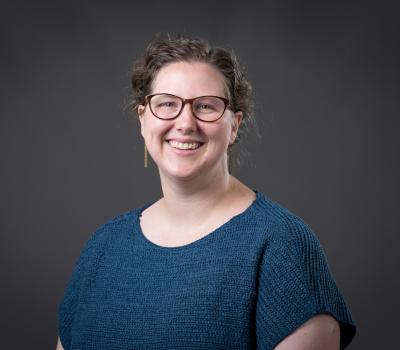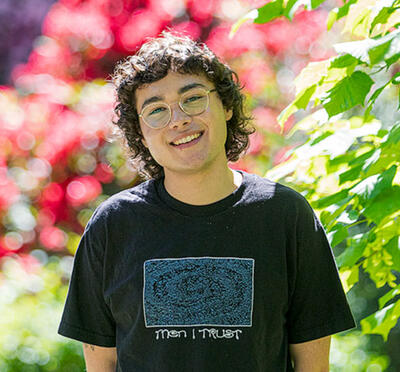Before joining the College of Engineering in 2021 as an assistant professor of bioengineering, Heidi Kloefkorn had mastered the art of pursuing multiple interests. No wonder she was drawn to the field of biomedical engineering.
“I’m in a field that has no united definition, and no degree holder is the same,” Kloefkorn said. “Bioengineers and biomedical engineers have a unique position, talking to scientists, engineers, and the medical field. We welcome all; it’s a fun space to be in.”
Discovering this space was a process fueled by Kloefkorn’s curiosity. Growing up, she gleaned career insights from her father, an electrical engineer, and her mother, a hematologist; however, her main catalyst was a virology seminar she took in high school.
“My teacher got me excited about public health — not only the biology of viruses, but engineering controls we use to protect ourselves and equipment we use to understand organisms. That was just as interesting to me as all the biological aspects,” Kloefkorn said.
Pursuing this interest, Kloefkorn enrolled at Georgia Tech to study biomedical engineering and joined the honors program, which provided the opportunity to perform research in a comparative neuromechanics lab.
“My first experiment was comparing different prostheses for below-the-knee amputee patients in terms of quantifying gait locomotion, three-dimensional kinematics, and kinetics,” Kloefkorn said. “Then, I had an entirely different research experience in electrophysiology. I knew nothing about neuroscience and had never worked with animals before, but I was paired with an amazing postdoc who mentored me. I decided I wanted to continue research because it was fun to go to the lab every day and do something different.”
Kloefkorn’s decision led her to the biomedical engineering doctoral program at the University of Florida, where she worked in a lab specializing in emerging diagnostics and therapeutics for joint disease, specifically working in preclinical osteoarthritis models. She developed hardware systems for conducting noninvasive gait biomechanics research in rodents as well as histological scoring analytics.
“We could ask and answer questions nobody had before, which was exciting,” Kloefkorn said. “Our work improved animal measures to better study and predict osteoarthritis pathogenesis in ways impossible to conduct in humans, with the ultimate goal to improve preclinical-to-clinical translation.”
Upon earning her doctorate, Kloefkorn moved to Emory University for a postdoctoral scholar position with the National Institutes of Health-sponsored FIRST Program. Her decision was inspired by her postdoc mentor, Katherine Wilkinson, who had held the same position when she worked with Kloefkorn at Georgia Tech.
Through FIRST, Kloefkorn obtained pedagogical training and classroom experience at Morehouse College, where she taught first-year biology. During this time, her research focus shifted from osteoarthritis to neuroscience, and her faculty advisor was glad to incorporate Kloefkorn’s experience in animal behavior in their lab.
“I worked with cutting-edge technology to build new tools to measure animal physiology and behavior noninvasively from outside the homecage — something no one had been able to do before,” Kloefkorn said. “We measured fundamental physiology and behavior, like respiration, heart rate, and motor behavior. The animal doesn’t even know they're being recorded; that’s the magic of it.”
Kloefkorn brings skills in developing noninvasive observation technology, experience in degenerative and chronic pain models, and histological and electrophysiological tissue analysis. She is setting up her lab with workstations for spatiotemporal and dynamic gait biomechanics, automated computational analytics, tissue histology, animal behavior, and electrophysiology. This breadth allows for interdisciplinary collaboration, as Kloefkorn fosters a team-based dynamic among her trainees.
“I’ve had a history of amazing mentors and advocates. They’ve been part of my journey, something I’m grateful for and try to pass forward. Including undergrads in research gives them practical experience to apply what they’ve learned in a setting that doesn’t have a textbook. The long-term plateau I’m hoping to achieve is three or four graduate students and several undergrads at any given time,” Kloefkorn said.
Kloefkorn encourages her students to specialize in two areas of her research program while becoming proficient in others. Using the equipment developed in her lab, Kloefkorn and her team intend to conduct parallel translational studies, measuring the same physiological phenomenon in animals and humans simultaneously to minimize the preclinical-to-clinical gap.
“Biomedical engineering is a collaborative empowerment to answer the next stage of difficult medical questions,” Kloefkorn said. Every advance has an impact and bolsters that foundation for your next steps. There’s so much unknown we need to discover and many people we need to help. This freedom of creativity to just go and try something — that’s what’s exciting.”




